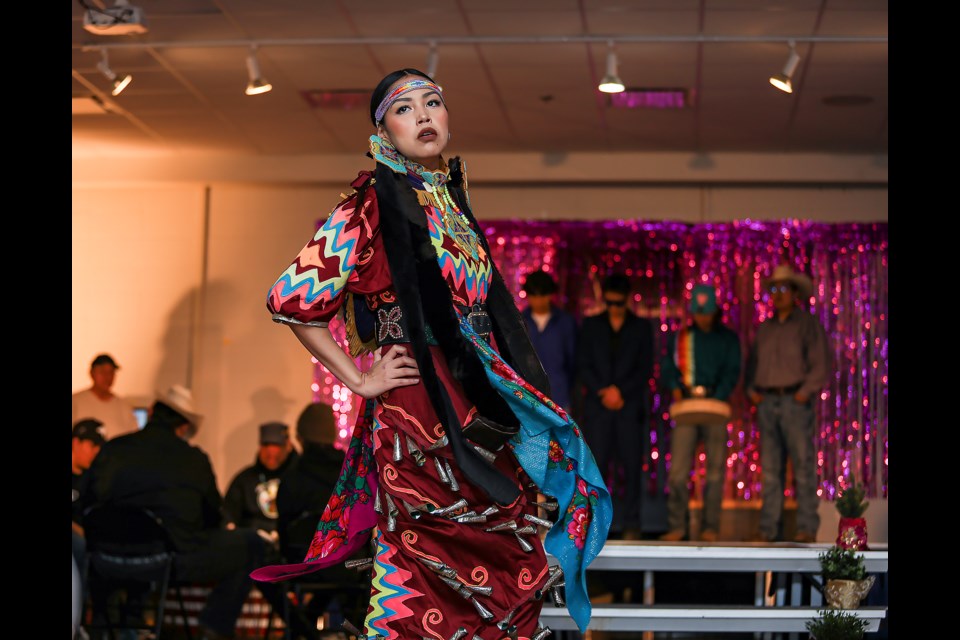Precious Poucette didn’t know how to create her own ribbon skirt when she first joined the Mînî Thnî Community School powwow academy.
But by the end of the 2022-23 school year, the Grade 10 student proudly walked the catwalk wearing a ribbon skirt she sewed with her own two hands, in a display of not only reconnecting with her culture, but also honouring the life of one of her best friends.
“There’s been a lot of challenges and adversities students have encountered over the school year – I’ve literally seen blood, sweat and tears,” said Heather Ketchemonia, the school’s powwow academy instructor. “I had a student that actually sewed her finger, and I also had a student who made a ribbon skirt with a broken heart – she had tears falling as she was making it.”
Poucette’s ribbon skirt, adorned in a meticulously stitched combination of black, with white and red stripes, along with sparkling sequins, featured a heart surrounding a carefully crafted No. 18 on the side.
The number adorned the jersey of the late Jacobi Dixon, an avid hockey player in the community and a student at the school, who tragically lost his life in a car accident at the tender age of 18, just weeks before the end of the school year.
Dixon’s life was honoured by students and staff at the powwow academy’s second annual fashion show on Thursday (June 1), which was primarily a celebration to showcase participating students’ hard work.
“I figured my best friend that I made my ribbon skirt for would probably love what I’m doing for him,” said Poucette. “It helped me a lot, thinking about him while I was putting it together. I just thought about all the happy memories we made.”
The academy, open to Grades 10-12, teaches those interested how to create their own regalia. When not busy with needle and thread, students are learning how to dance so they may use their regalia on the powwow trail, if they choose.
“A lot of them come in with no dancing experience or no sewing experience,” said Ketchemonia. “Creating regalia, whether it’s a ribbon skirt, a jingle dress, or anything else, can be a really healing experience.
“We have a lot of students who have lost friends too soon or parents too soon, and some of them are hurting. But connecting with their culture this way, dancing, and sometimes getting them out of their comfort zone, is huge.”
The academy first started in 2019 when students began gathering in Ketchemonia’s classroom to practice different styles of powwow dance over the lunch break. As more students began showing up, Ketchemonia was encouraged to start a credited course, focused on her passion for sewing regalia and teaching students how to dance.
While some students opt not to pursue powwow dancing, they are forging their own paths, honing their sewing skills and becoming master sewers in their own right.
“We have one student who is an amazing sewer. She can whip out a ribbon skirt in no time at all,” said Ketchemonia. “That’s something that can become a career or a side hustle. She can sell her skirts and dresses and make money to buy more material and keep creating.”
This year, Grade 12 student Zade Eagleplume created a jingle dress, used in a style of women’s powwow dance that is an act of healing and pride.
Regalia worn in the dance is referred to as a jingle dress because it includes multiple rows of metal cones that create a jingling sound as the dancer moves, their feet treading lightly across the ground.
Eagleplume was also a close friend to the late Dixon. Before performing a solo jingle dance in his honour, she delivered a heartfelt and emotional tribute to his memory.
After the show, she spoke of her experience being enrolled in the powwow academy and how it has positively influenced her journey as a young Indigenous woman.
“It keeps me closer to the Creator that I believe in,” she said. “It lifts up my spirit and it makes me happy.”
Duane Mark, Stoney language and cultural coordinator at Mînî Thnî Community School, was the master of ceremonies for the fashion show. He said the powwow academy’s year-end event is an inspiration to other students. The whole school is invited to watch and younger students from Nakoda Elementary School are also welcome.
“These students are acting as role models to some of those younger than them. When they see their performances and the skills they’ve learned, it becomes a real motivating factor, for pride and identity,” he said.
“It’s not that they don’t have those things, but it further strengthens their resolve and their identity as Stoney Nakoda people.”
The Local Journalism Initiative is funded by the Government of Canada. Jessica Lee's position covers Îyârhe (Stoney) Nakoda First Nation and Kananaskis Country.




